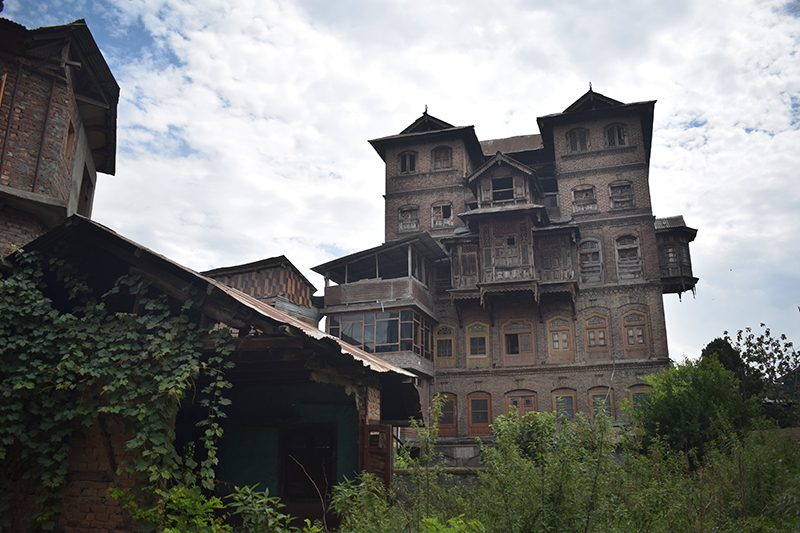“It was believed that the lights reflecting from the vehicles coming from Banihal could be seen from the top storey of the house.”
Arising from the vast foliage of grapevines invading its walls, an enigmatic house stands tall despite dented by weather and woes of the land. Secluded from the bustling marketplace the unusual height of the house makes the top storey appear to be gradually merging with the clouds looming over it. The slow rustling of leaves amidst a dead silence makes the atmosphere eerie. Home to secrets, speculations and stories, the structure appears to be staring blankly into nothingness.
The house stands next to Cheeni Cowk—an old heart and hub of the town—inside the Nazuk Mohallah of district Anantnag. This where this Sath’pohar Makaan or the seven storied house is situated.
As per the date engraved on its main door, the house dates back to somewhere around 1990 Vikrami year.
The Vikrami calendar is a Hindu calendar that is generally 57 years ahead of the Gregorian Calendar. Keeping that in view the house is approximately 86 – 88 years old.
It was in 1972 that the owner of the house Pandit Haldar Cherwoo sold the property to Ghulam Ahmad Shah and Abdul Ali Shah before leaving for the US.
“I’ve heard from my forefathers that the deal carried such a clout that people from all different places upto Mumbai were showing interest in who was able to manage to buy the house,” says Khursheed Shah, the third generation resident.
“It was with great difficulty that my grandfather and his brother managed to approach Pandit Haldar. Pandits were economically very sound and the huge class difference made it very difficult to fraternize with them.”
Legend has it that Pandit Haldar alongwith two of his friends had decided to hold a contest amongst each other for building the tallest house. They even began the construction work together but it was Pandit Haldar’s house that stood the test of time becoming one of the tallest residential houses in Kashmir.
Two of its seven stories, one of which is underground, have been built using stones followed by five more stories made from raw bricks. Piles of wood logs were laid on top of each other held together using eggs and surki before laying the plinth of the house.
“Since two of its stories have been built using stones we had thought of making some changes in order to modernize the kitchen area but till date we haven’t been able to find a way to do that,” Shah continues. “I called a few experts who visited and accessed the situation but no one was able to help us.”
The pinpoint accuracy with which the construction process has been carried out and the techniques used to perform the task of carrying raw materials to such a height in those days is beyond Shah’s understanding. “Even the wind direction has been taken into consideration while roofing the house.”

Engraved Entrance. [FPK Photo/Muzzamil Bashir.]
Comprising a total of 27 rooms built in an indigenous Kashmiri style, the house is an architectural masterpiece. The vernacular architectural techniques and structures that have been incorporated in it—the Khatamband, Pinjra Qari, Zoone Dab, Varoosi, Taaq, Dhaje Dewari, etc—are reflective of the richness of Kashmiri heritage.
“It was believed that the lights reflecting from the vehicles coming from Banihal could be seen from the top storey of the house,” says Shah. “A stream of water arising from a nearby spring would flow right next to the house. It was around 18 feet wide back in the day but has now shrunk to a 3 foot drain.”
In the course of history, the glorious structure eventually became harrowing.
Holding in its embrace the Khwaja Reshi shrine, the speculations of supernatural beings inhabiting the house are very common among the people living in and around the area. People avoid passing through the lane particularly during the night hours because of the fear of getting possessed by spirits. Elderly women even recount tales of hearing loud screams coming from the house at nights and children are advised to stay away from the structure.
“The house was feared so much that when my elder brother once went into the lane while playing outside, I rushed home crying and told everyone that my brother isn’t coming back ever,” says a man living in the neighborhood.
But Shah rubbishes the rumors of any such unnatural occurrences taking place in the house. “I’ve grown up in the house and am still living there with my children,” he says. “It was in 1972 when I shifted to this house with my family and ever since I have lived here. I do not remember any such incident of spirits possessing any of us. We did however lock up the top stories because maintaining such a big house is not an easy task.”
The area was home to prominent Pandits who held good government posts. Since commoners did not have much access to the area, says Abdul Salam, the inaccessibility fuelled the rumors. “A few miscreants were also involved in creating panic amongst people to scare away the Muslim population from the area,” Salam, a retired PDD employee living in Janglatmandi, says. “It was their ignorance that led them to believing in all sorts of rumors.”

Home they don’t make anymore. [FPK Photo/Muzzamil Bashir.]
Amid all this, the towering structure continues to amaze one and all. The deep sense of nostalgia and longing is palpable from the lengths and breadths of its walls. The house has survived multiple natural calamities, a few devastating floods being the most important ones with water levels rising up to its third floor. But the structure stands undefeated standing as a testament to the wisdom of the people involved in its making.








